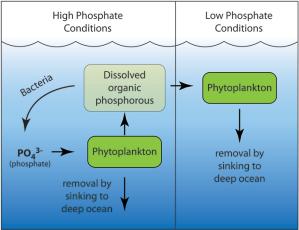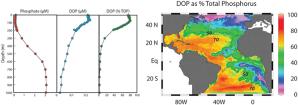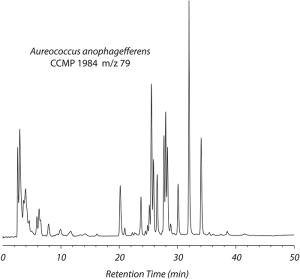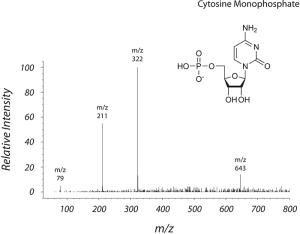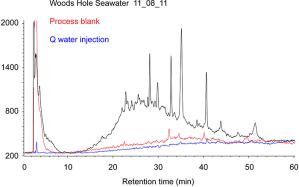Speciation of dissolved organic phosphorus in seawater
All living organisms require phosphorus (P) to synthesize DNA, RNA, ATP, and a host of other essential organic compounds. Marine P is supplied by continental weathering, and in many areas of the remote ocean, far removed from land (e.g. North Pacific Subtropical Gyre, the Sargasso Sea) and other semi-enclosed seas nearly surrounded by land (e.g. Mediterranean Sea), marine productivity is limited by the amount of phosphorus present in seawater. Phosphate ion (PO43- ) is the most biologically available form of phosphorus. Rapid biological uptake of phosphate strips P from the sunlit euphotic zone, often driving phosphate concentrations down to low nM levels. After death, phytoplankton sink into the deep ocean, where regeneration processes allow phosphate values to rebound below 200m (Figure 1). Although marine primary production removes phosphate from the upper ocean, it also releases organic phosphorus into the water column. Even in P limited mid ocean gyres, dissolved organic phosphorous (DOP) accumulates to concentrations in excess of 100-300 nM (Figure 2). Biological uptake reduces DOP concentrations to near zero levels in the deep ocean, resulting in depth profiles of phosphate and DOP that are mirror images of each other (Figure 2).
There is growing evidence that DOP supports a significant amount of the annual primary production in highly stratified, phosphate depleted waters. As the planet warms and stratification in ocean gyres strengthens, phosphorous limitation may become even more acute, and microbes that can access the large stock of DOP sequestered in the upper ocean will have a significant competitive advantage. However, we know little about the chemical composition, origin, and fate of DOP in the ocean. The goal of our project is to identify key DOP constituents and use them experimentally as tracers of DOP cycling. We are actively developing new analytical methods to do this, including high pressure liquid chromatography coupled to inductively coupled and electrospray ionization mass spectrometry (HPLC-ICP-MS and HPLC-ESI-MS respectively) (Figure 3). Using these techniques we have identified major DOP constituents in laboratory cultures (Figure 4) and are beginning to describe the distribution of DOP in seawater (Figure 5).
